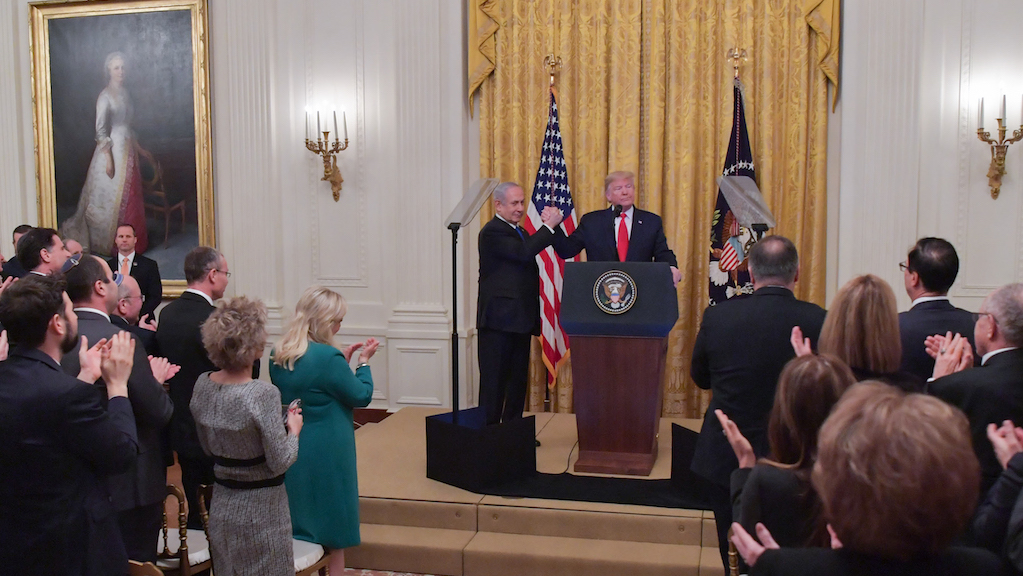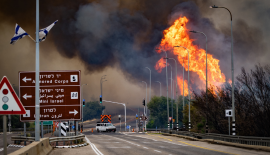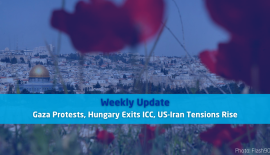Trump’s ‘Peace to Prosperity’ Plan Unveiled
Tuesday, 28 January 2020 was one of the most extraordinary days in Israel’s history. Attorney-General Mandelblit filed an official indictment against Prime Minister Netanyahu on counts of bribery, fraud, and breach of trust – an hour after Netanyahu withdrew his application to the Knesset for immunity when it became clear that he could muster no majority. This is the first time in Israel’s history that a sitting Prime Minister has been officially charged with crimes. On the same day, in Washington, American president Donald Trump announced the political aspects of his long- awaited ‘Peace to Prosperity’ plan. ‘A realistic two-state solution’ is how he described it.
The Trump team, led by the President’s son-in-law, Jared Kushner, has worked for three years on the plan, which is unlike any peace plan proposed in relation to the conflict since the Oslo Accords of the mid-1990s. It reflects the broad principles for peace set out in the UN Security Council resolution 242 (1967).
Both Israeli Prime Minister Netanyahu and opposition leader Benny Gantz were invited to the presentation of the plan in Washington, as was Palestinian leader Mahmoud Abbas. The Israeli leaders accepted, but the PLO leader declined, calling Trump ‘a dog and the son of a dog’.
The presentation was also attended by leaders from Oman, Bahrein and the United Arab Emirates.
The Israeli leaders accepted, but the PLO leader declined, calling Trump ‘a dog and the son of a dog’.
The plan contains two parts: a Political Framework and an Economic Framework. The Economic Framework had previously been unveiled in June 2019.
Israeli PM Netanyahu has embraced the plan, as has Gantz’s Blue and White party. There is some opposition within right-wing parties to the idea of the creation of a Palestinian state of any sort.
The Palestinian leadership has rejected the plan outright. “I don’t have long to live”, Fatah representatives quoted Abbas as saying to the Jerusalem Post. “I don’t want to go down as a traitor. It’s either dying like martyrs or flying the Palestinian flag on the walls of Jerusalem”.
The Palestinian leadership under Abbas has made clear it will not accept anything less than the terms demanded by them consistently and many of which are reflected in UN resolutions such as Security council resolution 2334: full sovereignty over all of the territories captured by Israel in 1967 except for mutually agreed adaptations; removal of Israeli settlements; full Palestinian sovereignty over all of Jerusalem; and return of Palestinian refugees.
The plan conflicts with the mainstream interpretation of international law that underpins the UN and EU-sponsored approach to the conflict, supporting the PLO demands: Israel must end the occupation of the ‘Palestinian’ territories; all Israeli settlements in the occupied territories have been established illegally; the Palestinians have a right to statehood, and all of East Jerusalem is to become the capital of a Palestinian state. The plan is thus likely to receive much international criticism.
The US, on the other hand, considers that Israel has valid legal and historical claims to the territories captured in 1967, that it is not obliged to withdraw from all these territories, that Israeli settlements are not necessarily illegal, and that the Palestinian refugees do not have a right of return. A small number of states, such as Australia, support the US view on many of these issues.
‘Palestine’ has wide international support for its claims to sovereignty over the whole of the West Bank including East Jerusalem; has, since 2012, successfully acceded to tens of multilateral treaties, including the statute of the International Criminal Court; has been granted ‘UN non-member observer state status’ and is recognised as a state by over 130 states; and receives significant international funding.
Trump’s ‘Peace to Prosperity’ Plan Unveiled
The question is whether the Palestinians will now be willing to accept less: a demilitarised state that can only come into existence when they satisfy the demands of the USA. On the other hand, the Trump plan includes many incentives and benefits for the Palestinians, such as massive economic investment, state- building assistance, and regional recognition, should they accept the plan.
The Trump plan includes many incentives and benefits for the Palestinians, such as massive economic investment, state- building assistance, and regional recognition, should they accept the plan.
Some of the main aspects of the Political Framework are as follows:
Palestinian Statehood
The plan envisages the creation of a demilitarised Palestinian state, provided certain criteria are met. “The Palestinians deserve a better future mid-1990s and this Vision can help them achieve that future. Palestinian leaders must embrace peace by recognising Israel as the Jewish state, rejecting terrorism in all its forms, allowing for special arrangements that address Israel’s and the region’s vital security needs, building effective institutions and choosing pragmatic solutions. If these steps are taken and the criteria set forth in this Vision are satisfied, then the United States will support the establishment of a Palestinian State.”
Negotiations Leading to a Peace Agreement
The plan envisages both Israel and the Palestinians to take various steps that would lead to a binding peace agreement to end the conflict.
Jerusalem
Jerusalem west of the security barrier will remain undivided under Israeli sovereignty. A Palestinian capital can be established in the area of Jerusalem outside the barrier. Jordan retains control over the Temple Mount.
Territory, Borders and Settlements
The plan contains a map showing the borders of the proposed future Palestinian state. The Palestinian state would cover all of current Areas A and B as well as about 70% of Area C. These areas are connected by major roads. A tunnel connects Gaza and the Palestinian state. Israel retains sovereignty over the Jordan Valley. No Israeli settlements are to be forcibly removed.
Security
The proposal contains extensive arrangements designed mainly to protect Israel’s right to security.
Gaza
Hamas and Palestinian Jihad are to be disarmed, and the Palestinian Authority is to have control over Gaza. A range of proposals is intended to improve the economic conditions in Gaza. This includes adding territory close to the Gaza strip to enable new infrastructure to be built.
Regional Development
The plan promotes regional cooperation and integration. Both Jordan and Egypt will have an important role to play in determining whether the plan obtains political support in the region, and if so, the success of the plan’s implementation. There will be a free trade zone between Jordan and the State of Palestine.




